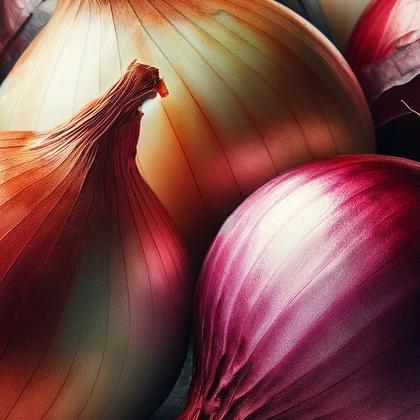Onions

The onion (Allium cepa) (Latin 'cepa' = onion), also known as the bulb onion or common onion, is used as a vegetable and is the most widely cultivated species of the genus Allium. This genus also contains several other species variously referred to as onions and cultivated for food, such as the Japanese bunching onion (A. fistulosum), the Egyptian onion (A. ×proliferum), and the Canada onion (A. canadense). The name "wild onion" is applied to a number of Allium species but A. cepa is exclusively known from cultivation and its ancestral wild original form is not known, although escapes from cultivation have become established in some regions. The onion is most frequently a biennial or a perennial plant, but is usually treated as an annual and harvested in its first growing season.The onion plant has a fan of hollow, bluish-green leaves and the bulb at the base of the plant begins to swell when a certain day-length is reached. In the autumn the foliage dies down and the outer layers of the bulb become dry and brittle. The crop is harvested and dried and the onions are ready for use or storage. The crop is prone to attack by a number of pests and diseases, particularly the onion fly, the onion eelworm and various fungi that cause rotting. Some varieties of A. cepa such as shallots and potato onions produce multiple bulbs.Onions are cultivated and used around the world. As a foodstuff they are usually served cooked, as a vegetable or part of a prepared savoury dish, but can also be eaten raw or used to make pickles or chutneys. They are pungent when chopped and contain certain chemical substances which irritate the eyes. Onions contain phenolics and flavonoids that have potential anti-inflammatory, anti-cholesterol, anticancer and antioxidant properties.
Onions Pairs With:

Onions Properties:
| Food Property | Type | Description |
|---|---|---|
| Flavor Profile | Sweet | Onions have a slightly sweet flavor when cooked. |
| Sour | Onions are not typically sour in flavor. | |
| Salty | Onions are not salty in flavor. | |
| Bitter | Onions can have a slightly bitter taste, especially when raw. | |
| Umami | Onions do not have a prominent umami flavor. | |
| Texture | Firmness | Onions are firm in texture when raw, but become softer when cooked. |
| Moisture | Onions have a high moisture content. | |
| Nutritional Value | Fiber | Onions are a good source of dietary fiber. |
| Micronutrients | Onions contain micronutrients such as vitamin C and potassium. | |
| Color | Natural Pigments | Onions have a natural white, yellow, or red color depending on the variety. |
| Aroma | Volatile Compounds | Onions have a strong aroma due to volatile compounds released when cut. |
| Chemical Composition | Acidity/Alkalinity (pH) | Onions are slightly acidic in nature. |
| Cooking Behavior | Water Retention | Onions release water when cooked but can also absorb liquids. |
| Oil Absorption | Onions can absorb oil when sautéed. |
Food Pairing App - Version 1.2.0
